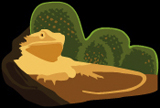
Leasing / Rentals
Available Enclosures
Habitats

A Tropical Living Vivarium is designed to take you away to a tropical paradise. From the naturalistic background, exotic tropical plants and rugged wood, its as if a chunk of the Amazon was dropped into a glass enclosure.
Much like salt and fresh water aquariums, Tropical Vivariums can ease stress, lower blood pressure and even reduce anxiety. These physiological benefits also extend to the inhabitants - the small reptile and amphibian species that are housed in Tropical Living Vivariums display more active and natural behavior then their other captive cousins because of their naturalistic home.

With the way we design our enclosures, it is probably harder to kill a Tropical Living Vivarium then it is to keep it alive. It is virtually self containing. Beneficial micro organisms that exist in the substrate help to decompose and digest waste and this also eliminates any negative odor. When equipped with a misting system and lighting with a timer, daily maintenance really isn't needed.
The only variable is what type of animals you decide to keep in your Living Vivarium. You will want to make notes of how often to feed your pets and if they deposit large feces it is a good idea to spot clean once a week.
If you want your enclosure to be truly stress free, Bama Reptiles offers full maintenance and service programs with the purchase of a Tropical Living Vivarium. You can also rent / lease a Tropical Living Vivarium and those come with full maintenance and service. Click here for more information.

All standard and premium Living Vivariums are built in your standard reptile/amphibian glass enclosures. Standard Living Vivariums are built in common sliding screen glass enclosures, similar to the common aquarium enclosure. Premium Living Vivariums are built in Zoo Med or Exo-Terra naturalistic enclosures that are designed to house Living Vivariums.
The naturalistic background is made from expanding foam and covered in grounded coconut husk, a common and clean soil used by reptile breeders and hydroponic enthusiasts. All materials we use are safe for both human and inhabitants. We have kept numerous species of reptile and amphibian in the same enclosures for years.

Who doesn't enjoy the sound of flowing water? You can have that sound permanently when you have a Tropical Living Vivarium with a built in waterfall. Waterfalls add another dimension to Tropical Living Vivariums and they have benefits too. It helps to maintain a high humidity and it can stimulate natural behavior from its inhabitants.
We build our waterfalls out of foam covered in a mixture of crushed Lava Rock and grounded coconut husk. The end result is the appearance of a solid Lava Rock waterfall, similar to those found on the beautiful Hawaii Islands. The waterfall flows into a small pond area that also has a layer of Lava Rock at the bottom.
We use hydroton clay pebbles at the bottom of the planting area so that the soil isn't constantly soaked in water and drowns the plants. Each of our waterfalls are built by hand, giving you a truly unique feature.

A quality misting system is a must have for every Tropical Living Vivarium. Having an automated misting system greatly reduces the daily maintenance of displaying a Tropical Living Vivarium. We use Mist King misting systems on our enclosures.

Our tropical plant selection is partly based on what is available at the local nurseries and what we are propagating in our own nursery. Some of the most common plants we use include: bromeliads, orchids, pothos, sansevieria, ficus, creeping fig, spider plants, umbrella plants and various ferns.

We collect our wood from private pristine environments including woodlands, deserts and shrubbery areas. We make sure the land we collect from is free from pesticides and other harmful things. We NEVER use any pine or cedar products due to the toxic oils in the bark.